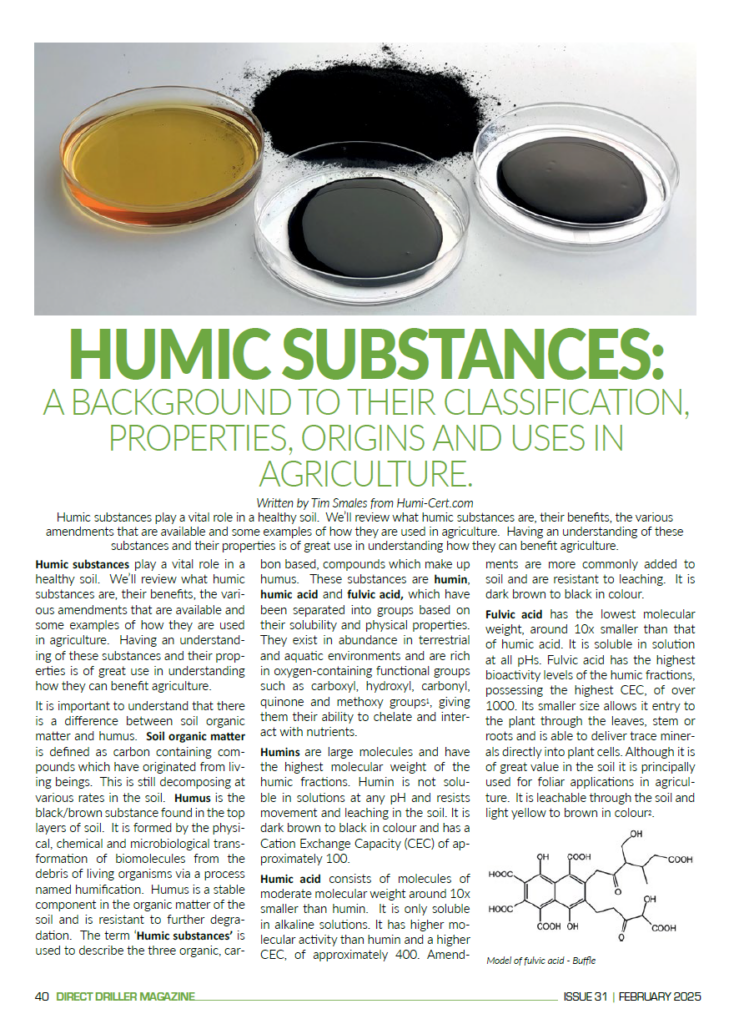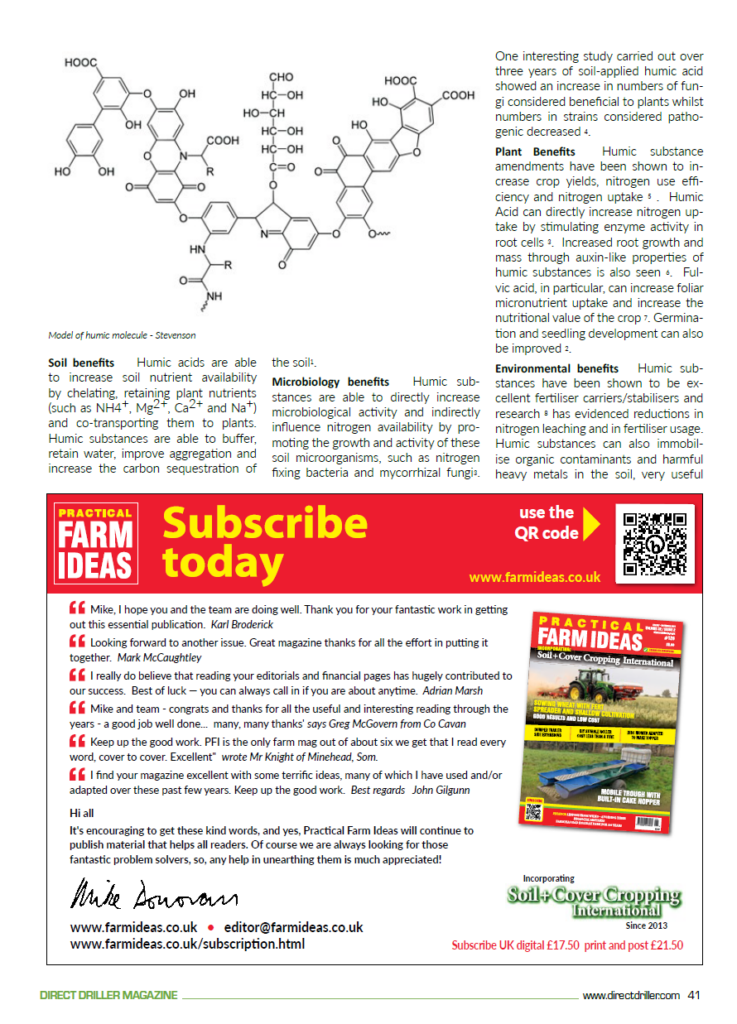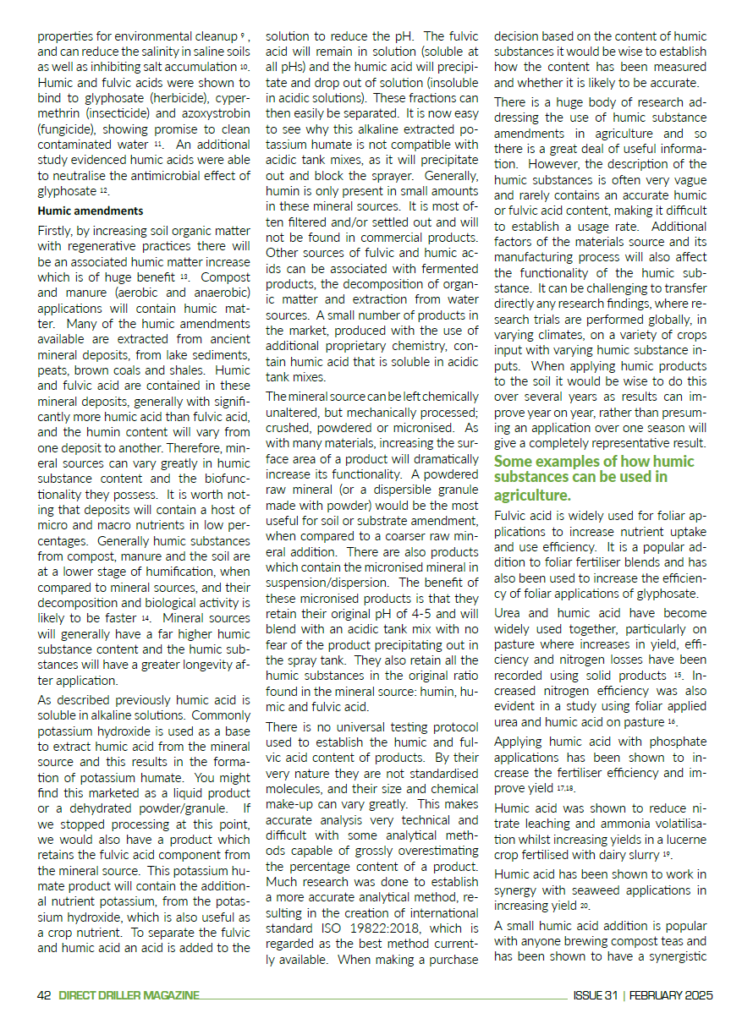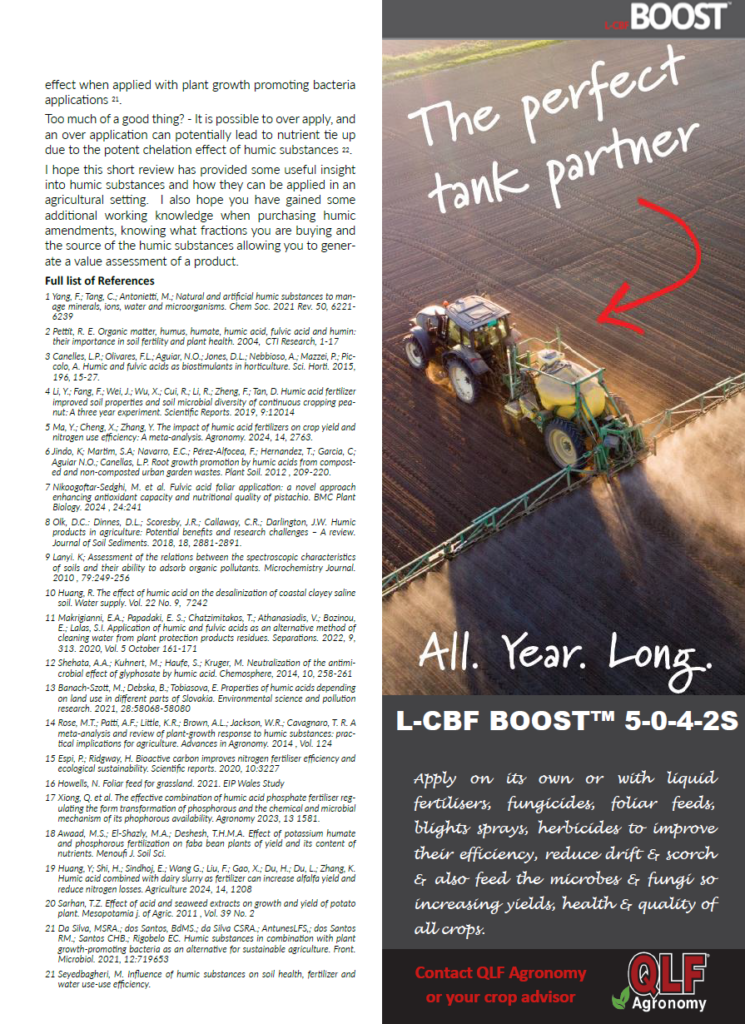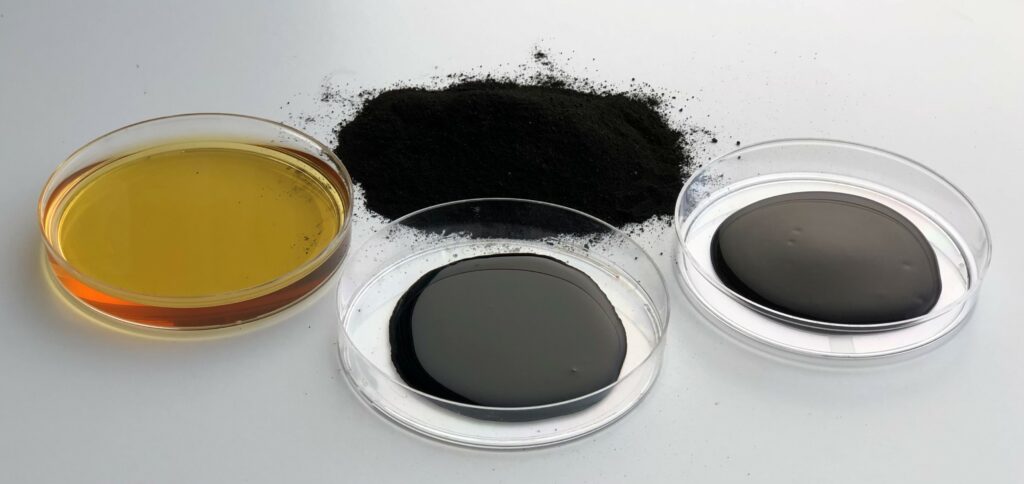Written by Tim Smales from Humi-Cert.com
Humic substances play a vital role in a healthy soil. We’ll review what humic substances are, their benefits, the various amendments that are available and some examples of how they are used in agriculture. Having an understanding of these substances and their properties is of great use in understanding how they can benefit agriculture.
It is important to understand that there is a difference between soil organic matter and humus. Soil organic matter is defined as carbon containing compounds which have originated from living beings. This is still decomposing at various rates in the soil. Humus is the black/brown substance found in the top layers of soil. It is formed by the physical, chemical and microbiological transformation of biomolecules from the debris of living organisms via a process named humification. Humus is a stable component in the organic matter of the soil and is resistant to further degradation. The term ‘Humic substances’ is used to describe the three organic, carbon based, compounds which make up humus. These substances are humin, humic acid and fulvic acid, which have been separated into groups based on their solubility and physical properties. They exist in abundance in terrestrial and aquatic environments and are rich in oxygen-containing functional groups such as carboxyl, hydroxyl, carbonyl, quinone and methoxy groups 1, giving them their ability to chelate and interact with nutrients.
Humins are large molecules and have thehighest molecular weight of the humic fractions. Humin is not soluble in solutions at any pH and resists movement and leaching in the soil. It is dark brown to black in colour and has a Cation Exchange Capacity (CEC) of approximately 100.

Humic acid consists of molecules of moderate molecular weight around 10x smaller than humin. It is only soluble in alkaline solutions. It has higher molecular activity than humin and a higher CEC, of approximately 400. Amendments are more commonly added to soil and are resistant to leaching. It is dark brown to black in colour.
Fulvic acid has the lowest molecular weight, around 10x smaller than that of humic acid. It is soluble in solution at all pHs. Fulvic acid has the highest bioactivity levels of the humic fractions, possessing the highest CEC, of over 1000. Its smaller size allows it entry to the plant through the leaves, stem or roots and is able to deliver trace minerals directly into plant cells. Although it is of great value in the soil it is principally used for foliar applications in agriculture. It is leachable through the soil and light yellow to brown in colour 2.
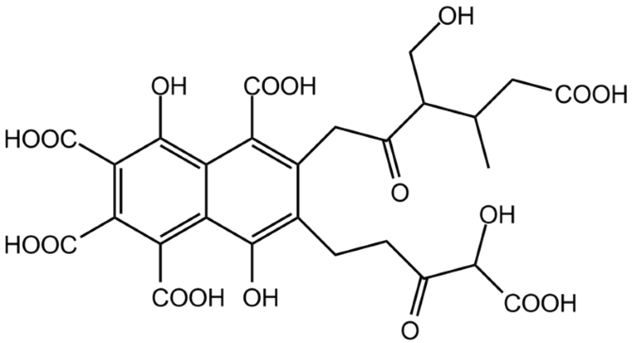
Soil benefits Humic acids are able to increase soil nutrient availability by chelating, retaining plant nutrients (such as NH4+, Mg2+, Ca2+ and Na+) and co-transporting them to plants. Humic substances are able to buffer, retain water, improve aggregation and increase the carbon sequestration of the soil 1.
Microbiology benefits Humic substances are able to directly increase microbiological activity and indirectly influence nitrogen availability by promoting the growth and activity of these soil microorganisms, such as nitrogen fixing bacteria and mycorrhizal fungi3. One interesting study carried out over three years of soil-applied humic acid showed an increase in numbers of fungi considered beneficial to plants whilst numbers in strains considered pathogenic decreased 4.
Plant Benefits Humic substance amendments have been shown to increase crop yields, nitrogen use efficiency and nitrogen uptake 5 . Humic Acid can directly increase nitrogen uptake by stimulating enzyme activity in root cells 3. Increased root growth and mass through auxin-like properties of humic substances is also seen 6. Fulvic acid, in particular, can increase foliar micronutrient uptake and increase the nutritional value of the crop 7. Germination and seedling development can also be improved 2.
Environmental benefits Humic substances have been shown to be excellent fertiliser carriers/stabilisers and research 8 has evidenced reductions in nitrogen leaching and in fertiliser usage. Humic substances can also immobilise organic contaminants and harmful heavy metals in the soil, very useful properties for environmental cleanup 9 , and can reduce the salinity in saline soils as well as inhibiting salt accumulation 10. Humic and fulvic acids were shown to bind to glyphosate (herbicide), cypermethrin (insecticide) and azoxystrobin (fungicide), showing promise to clean contaminated water 11. An additional study evidenced humic acids were able to neutralise the antimicrobial effect of glyphosate 12.

Humic amendments
Firstly, by increasing soil organic matter with regenerative practices there will be an associated humic matter increase which is of huge benefit 13. Compost and manure (aerobic and anaerobic) applications will contain humic matter. Many of the humic amendments available are extracted from ancient mineral deposits, from lake sediments, peats, brown coals and shales. Humic and fulvic acid are contained in these mineral deposits, generally with significantly more humic acid than fulvic acid, and the humin content will vary from one deposit to another. Therefore, mineral sources can vary greatly in humic substance content and the biofunctionality they possess. It is worth noting that deposits will contain a host of micro and macro nutrients in low percentages. Generally humic substances from compost, manure and the soil are at a lower stage of humification, when compared to mineral sources, and their decomposition and biological activity is likely to be faster 14. Mineral sources will generally have a far higher humic substance content and the humic substances will have a greater longevity after application.
As described previously humic acid is soluble in alkaline solutions. Commonly potassium hydroxide is used as a base to extract humic acid from the mineral source and this results in the formation of potassium humate. You might find this marketed as a liquid product or a dehydrated powder/granule. If we stopped processing at this point, we would also have a product which retains the fulvic acid component from the mineral source. This potassium humate product will contain the additional nutrient potassium, from the potassium hydroxide, which is also useful as a crop nutrient. To separate the fulvic and humic acid an acid is added to the solution to reduce the pH. The fulvic acid will remain in solution (soluble at all pHs) and the humic acid will precipitate and drop out of solution (insoluble in acidic solutions). These fractions can then easily be separated. It is now easy to see why this alkaline extracted potassium humate is not compatible with acidic tank mixes, as it will precipitate out and block the sprayer. Generally, humin is only present in small amounts in these mineral sources. It is most often filtered and/or settled out and will not be found in commercial products. Other sources of fulvic and humic acids can be associated with fermented products, the decomposition of organic matter and extraction from water sources. A small number of products in the market, produced with the use of additional proprietary chemistry, contain humic acid that is soluble in acidic tank mixes.
The mineral source can be left chemically unaltered, but mechanically processed; crushed, powdered or micronised. As with many materials, increasing the surface area of a product will dramatically increase its functionality. A powdered raw mineral (or a dispersible granule made with powder) would be the most useful for soil or substrate amendment, when compared to a coarser raw mineral addition. There are also products which contain the micronised mineral in suspension/dispersion. The benefit of these micronised products is that they retain their original pH of 4-5 and will blend with an acidic tank mix with no fear of the product precipitating out in the spray tank. They also retain all the humic substances in the original ratio found in the mineral source: humin, humic and fulvic acid.
There is no universal testing protocol used to establish the humic and fulvic acid content of products. By their very nature they are not standardised molecules, and their size and chemical make-up can vary greatly. This makes accurate analysis very technical and difficult with some analytical methods capable of grossly overestimating the percentage content of a product. Much research was done to establish a more accurate analytical method, resulting in the creation of international standard ISO 19822:2018, which is regarded as the best method currently available. When making a purchase decision based on the content of humic substances it would be wise to establish how the content has been measured and whether it is likely to be accurate.
There is a huge body of research addressing the use of humic substance amendments in agriculture and so there is a great deal of useful information. However, the description of the humic substances is often very vague and rarely contains an accurate humic or fulvic acid content, making it difficult to establish a usage rate. Additional factors of the materials source and its manufacturing process will also affect the functionality of the humic substance. It can be challenging to transfer directly any research findings, where research trials are performed globally, in varying climates, on a variety of crops input with varying humic substance inputs. When applying humic products to the soil it would be wise to do this over several years as results can improve year on year, rather than presuming an application over one season will give a completely representative result.
Some examples of how humic substances can be used in agriculture.
Fulvic acid is widely used for foliar applications to increase nutrient uptake and use efficiency. It is a popular addition to foliar fertiliser blends and has also been used to increase the efficiency of foliar applications of glyphosate.
Urea and humic acid have become widely used together, particularly on pasture where increases in yield, efficiency and nitrogen losses have been recorded using solid products 15. Increased nitrogen efficiency was also evident in a study using foliar applied urea and humic acid on pasture 16.
Applying humic acid with phosphate applications has been shown to increase the fertiliser efficiency and improve yield 17,18.
Humic acid was shown to reduce nitrate leaching and ammonia volatilisation whilst increasing yields in a lucerne crop fertilised with dairy slurry 19.
Humic acid has been shown to work in synergy with seaweed applications in increasing yield 20.
A small humic acid addition is popular with anyone brewing compost teas and has been shown to have a synergistic effect when applied with plant growth promoting bacteria applications 21.
Too much of a good thing? – It is possible to over apply, and an over application can potentially lead to nutrient tie up due to the potent chelation effect of humic substances 22.
I hope this short review has provided some useful insight into humic substances and how they can be applied in an agricultural setting. I also hope you have gained some additional working knowledge when purchasing humic amendments, knowing what fractions you are buying and the source of the humic substances allowing you to generate a value assessment of a product.
Full list of References
1 Yang, F.; Tang, C.; Antonietti, M.; Natural and artificial humic substances to manage minerals, ions, water and microorganisms. Chem Soc. 2021 Rev. 50, 6221-6239
2 Pettit, R. E. Organic matter, humus, humate, humic acid, fulvic acid and humin: their importance in soil fertility and plant health. 2004, CTI Research, 1-17
3 Canelles, L.P.; Olivares, F.L.; Aguiar, N.O.; Jones, D.L.; Nebbioso, A.; Mazzei, P.; Piccolo, A. Humic and fulvic acids as biostimulants in horticulture. Sci. Horti. 2015, 196, 15-27.
4 Li, Y.; Fang, F.; Wei, J.; Wu, X.; Cui, R.; Li, R.; Zheng, F.; Tan, D. Humic acid fertilizer improved soil properties and soil microbial diversity of continuous cropping peanut: A three year experiment. Scientific Reports. 2019, 9:12014
5 Ma, Y.; Cheng, X.; Zhang, Y. The impact of humic acid fertilizers on crop yield and nitrogen use efficiency: A meta-analysis. Agronomy. 2024, 14, 2763.
6 Jindo, K; Martim, S.A; Navarro, E.C.; Pérez-Alfocea, F.; Hernandez, T.; Garcia, C; Aguiar N.O.; Canellas, L.P. Root growth promotion by humic acids from composted and non-composted urban garden wastes. Plant Soil. 2012 , 209-220.
7 Nikoogoftar-Sedghi, M. et al. Fulvic acid foliar application: a novel approach enhancing antioxidant capacity and nutritional quality of pistachio. BMC Plant Biology. 2024 , 24:241
8 Olk, D.C.: Dinnes, D.L.; Scoresby, J.R.; Callaway, C.R.; Darlington, J.W. Humic products in agriculture: Potential benefits and research challenges – A review. Journal of Soil Sediments. 2018, 18, 2881-2891.
9 Lanyi. K; Assessment of the relations between the spectroscopic characteristics of soils and their ability to adsorb organic pollutants. Microchemistry Journal. 2010 , 79:249-256
10 Huang, R. The effect of humic acid on the desalinization of coastal clayey saline soil. Water supply. Vol. 22 No. 9, 7242
11 Makrigianni, E.A.; Papadaki, E. S.; Chatzimitakos, T.; Athanasiadis, V.; Bozinou, E.; Lalas, S.I. Application of humic and fulvic acids as an alternative method of cleaning water from plant protection products residues. Separations. 2022, 9, 313. 2020, Vol. 5 October 161-171
12 Shehata, A.A.; Kuhnert, M.; Haufe, S.; Kruger, M. Neutralization of the antimicrobial effect of glyphosate by humic acid. Chemosphere, 2014, 10, 258-261
13 Banach-Szott, M.; Debska, B.; Tobiasova, E. Properties of humic acids depending on land use in different parts of Slovakia. Environmental science and pollution research. 2021, 28:58068-58080
14 Rose, M.T.; Patti, A.F.; Little, K.R.; Brown, A.L.; Jackson, W.R.; Cavagnaro, T. R. A meta-analysis and review of plant-growth response to humic substances: practical implications for agriculture. Advances in Agronomy. 2014 , Vol. 124
15 Espi, P.; Ridgway, H. Bioactive carbon improves nitrogen fertiliser efficiency and ecological sustainability. Scientific reports. 2020, 10:3227
16 Howells, N. Foliar feed for grassland. 2021. EIP Wales Study
17 Xiong, Q. et al. The effective combination of humic acid phosphate fertiliser regulating the form transformation of phosphorous and the chemical and microbial mechanism of its phophorous availability. Agronomy 2023, 13 1581.
18 Awaad, M.S.; El-Shazly, M.A.; Deshesh, T.H.M.A. Effect of potassium humate and phosphorous fertilization on faba bean plants of yield and its content of nutrients. Menoufi J. Soil Sci.
19 Huang, Y; Shi, H.; Sindhoj, E.; Wang G.; Liu, F.; Gao, X.; Du, H.; Du, L.; Zhang, K. Humic acid combined with dairy slurry as fertilizer can increase alfalfa yield and reduce nitrogen losses. Agriculture 2024, 14, 1208
20 Sarhan, T.Z. Effect of acid and seaweed extracts on growth and yield of potato plant. Mesopotamia j. of Agric. 2011 , Vol. 39 No. 2
21 Da Silva, MSRA.; dos Santos, BdMS.; da Silva CSRA.; AntunesLFS,; dos Santos RM.; Santos CHB.; Rigobelo EC. Humic substances in combination with plant growth-promoting bacteria as an alternative for sustainable agriculture. Front. Microbiol. 2021, 12:719653
21 Seyedbagheri, M. Influence of humic substances on soil health, fertilizer and water use-use efficiency.
